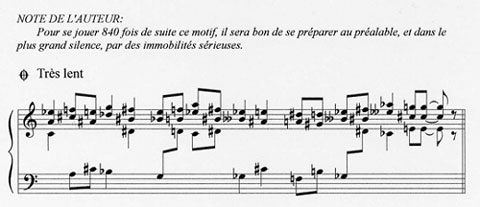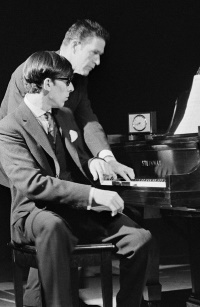

Timeline: 1963
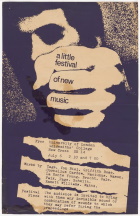
Farewell to Goldsmiths'
After winning the "most hateful student" award, given by its department heads, Cale pulls the plug at the end his college days on July 6, taking part in A Little Festival of New Music. He performs La Monte Young's X for Henry Flynt by kneeling at the piano and smashing the keys with his elbows. The audience came prepared for that piece, with trash cans and hammers they had brought with them.
"I was really wrapped up in writing pieces that were instructions. That's when I found La Monte Young, and Cage, and "4'33", which threw another spanner in the works, because it was really about how environment impacts performance. This is a peculiar American thing that was very fractured, because in Europe, the concert was sacrosanct: silence, and you listen. But you don't listen to Cage as much as you read him. If you read him in Silence, or A Year From Monday, you get a world outlook that's very interesting. The walls of the concert hall were not the only thing that he was breaking down."
At the same show Robin Page came screaming down from the balcony, performing Cale's Plant Piece. A potted plant was set on stage and the idea was to scream at it until it died. The plant survived, the audience was not that pleased. Piano Piece (unsequel music 212b) was the third Cale composition.
Goldsmiths' College would bestow Cale with an Honorary Fellowship in 1997.
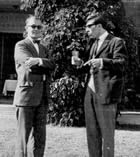
Studying at Tanglewood on a Leonard Bernstein scholarship
Starts his study on a Leonard Bernstein scholarship at the Eastman Conversatory in Tanglewood, Massachusetts, USA. American composer Aaron Copland, with whom Cale had been corresponding, helped him securing the scholarhip, but they have a falling out shortly afterwards:
"Copland said I couldn't play my work at Tanglewood. It was too destructive, he said. He didn't want his piano wrecked."
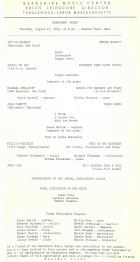
He performs one of his own compositions, Yn Y Dechreu Oedd Y Tail (Piano Four Hands), at a concert on August 15. His tutor is the Greek-French composer and architect Yannis Xenakis.
"Yannis's classes were unorthodox. He would put up theorems up on the board; they were the theoretical basis of the Fourier series, the Osternberg principle of probability. Probability theory was the basis on which he wrote his music. His classes were on extrapolating the probability of a B flat happening in the next three or four bars. This is stochastic music, his term for an alternative school of composition through serialism, which justifies its existence by its use of Heisenberg's uncertainty principle."
Moving to New York
In the Summer he moves to New York to continue his studies, after cashing in his return ticket to London. He finds an apartment on Lispenard Street (he would mention it in the lyrics of Hey Ray on the Extra Playful EP), sharing it with a roommate to split the rent.
"My first impression of New York was of the steam of the street systems pouring out their odors in the summer humidity. It was an apparition of a city that I saw that night. I had a sense of unseen power lurking in the shadows. This was the place I had dreamed of throughout my childhood, where I could accomplish anything, with the greatest visibility in the world. It was a city that never slept, that allowed any activity at any time and I was as much in love with the availability of all things to all people as I was with the hidden, unseen things that were to be my milieu for years to come - the underground."
He starts dabbling in drugs pretty quickly after his arrival in the Big Apple:
"When I got to New York, drugs were everywhere, and they quickly became part of my artistic experiment."
Orientalia bookshop
Works as a clerk at the Orientalia bookshop, Lower East Side, New York.
"Most of my days were spent putting together packages of books that had been ordered and sending them off. I'd go to work in the late morning and pack shipments to universities all over the world."
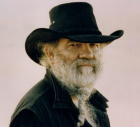
Joining La Monte Young
He gets in touch with La Monte Young, the leader of the avant-garde group that would later be named the Theatre of Eternal Music, in August. He first joins the ensemble for a rehearsal at LMY's 275 Church Street loft on September 29. Other members are Marian Zazeela and Tony Conrad.
"We learned about discipline and working every day from La Monte, about not particularly forcing anything to happen, but allowing things to happen. I think Cage liked how La Monte was writing instructions for performers. That's the original performance art. And those instructions didn't just deal with performance or music. "X for Henry Flynt" was a piece where you pick an event and then you repeat it X number of times with the same gap in time between it. "Draw a straight line and follow it," which was really about Einstein and space. If you draw a straight line and you come back to where you started, then space is finite. So you really didn't know what's performance and what's not.
Later, when La Monte and I were working together down here on Church Street, holding the drone for an hour and a half every day for a year and a half, it's like, "What is a performance? Where does it start and where does it end?" And his idea was that it didn't. He said it was a very Chinese idea at the time. Everybody else in Europe think about centuries. But China thinks in terms of eons.""
He plays a bunch of live performances with the ensemble, mainly in Philadelphia, Pittsburgh and New York, in 1964 and 1965.
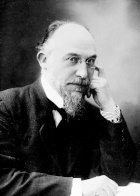
Performing Satie's Vexations
Cale is one of the eleven performers of Vexations, a composition for piano by French composer Eric Satie, who wrote these instructions about playing this piece:
"In order to play this piece 840 times, the performer should prepare beforehand in deep silence, and serious immobility."
Cale is up at four different time slots. Each one lasts 20 minutes.
He was invited by his mentor John Cage to be one of the performers. The performance at the Pocket Theatre in New York started on Monday September 9 and lasted for 18 hours and 40 minutes.
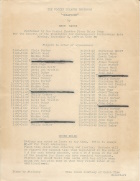
The show made headlines in the New York Times and a photo of Cale and Cage was printed with the review of the show.
"Time meant nothing, and the listener floated in a suspended animation as seconds flowed into minutes with the idiot repetition of beat after beat. Nirvana? Shanti, shanti, shanti."
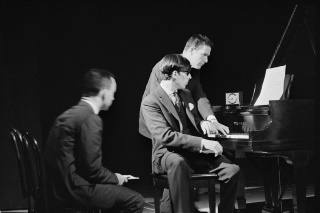
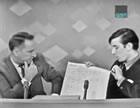
Appears on "I've Got A Secret"
He appeared shortly afterwards as a guest on the September 16 episode I've Got A Secret TV show and played through it just once. Karl Schenzer, an off-Broadway actor, the sole audience member who sat through the entire performance, was also a guest on the show.
